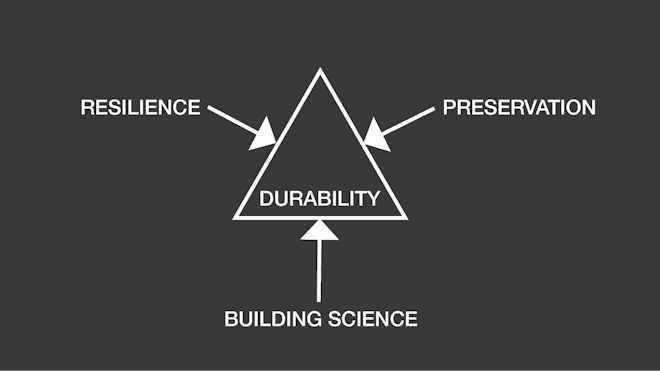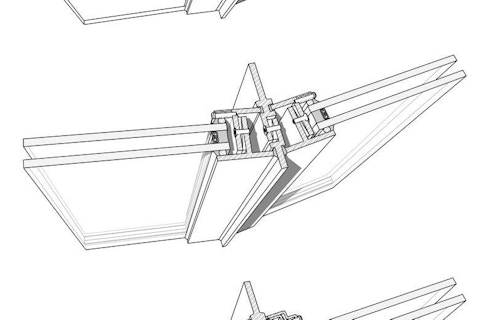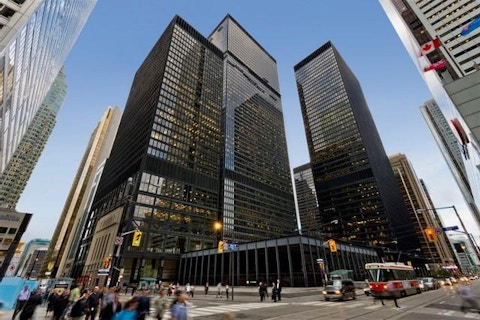Exploring Heritage: Building on the Past
Wait! Don't dismiss this issue if you are outside the preservation community. Without a solid historical foundation we are truly doomed to endlessly repeat those mistakes of the past that have yielded the existential threat we know as the climate crisis. A crisis that our industry, the building industry, has played a leading role in producing and now is called upon to lead the way to resolution. Accomplishing this necessitates deep insight into just how we got here, and much can be found in the historical context that is the purview of the building preservation community.
The heritage perspective is brought to us in this long anticipated issue of SKINS courtesy of guest editors from the Association of Preservation Technology’s (APT) Technical Committee on Modern Heritage (TC-MH) in collaboration with their Technical Committee on Sustainable Preservation (TC-SP). These folks took the time to curate and author the articles featured here. APT and FTI have been nurturing a collaborative relationship that began in 2015 and continues to mature, as described by David Fixler in the first feature below.
The substance, collective experience and expertise of the preservation community has profound relevance for the entire building industry and particularly for the design of new buildings and their facade systems, as well as the facade interventions that are a critical component of existing building renovations. Let me tell you why I believe this to be so important.
I was involved in late-career research on curtainwall systems through the 2010s with a particular focus on renovation practices and sustainability attributes. My research evolved to draw on three bodies of work: building science, historic preservation, and resilience. I started with building science, studying the performance attributes of curtainwall systems in the context of sustainability metrics. The work of Ted Kesik at the University of Toronto introduced me to the importance of durability and durability science and its manifestation in building assemblies as the metric of service life. Grappling with the nuances of durability led to ecological science and the concept of resilience, which at the time was just emerging as a growing concern in the building industry. While working through the building science literature, I was surprised by the frequency with which I encountered deeply relevant and insightful papers and articles from heritage organizations like the APT and DOCOMOMO. These documents proved quite useful and enlightening, revealing great insight on the various attributes, strengths and weaknesses of curtainwall systems. It makes sense, right? Historic preservation practitioners are regularly witness to how facade assemblies have performed in a broad variety of curtainwall applications over time.

All roads on my research journey unexpectedly converged at durability.
I started investigating what compromises durability and limits service life; the forces of obsolescence in curtainwall assemblies. So many of my assumptions throughout this research proved to be flat out wrong. I had assumed that degradation would be the leading cause of premature obsolescence in buildings and facade systems. The reality is far more complex and interesting, with social, technical, and aesthetic obsolescence, among a rather long list, far more common.
Ecological science introduced me to the concept of resilience and the ability to persist through adversity I and learned this is largely a function of adaptive capacity. Gradually, I came to realize that the challenges I was documenting in the rehabilitation of mid-century tall curtainwall buildings was because of their lack of adaptability, typically resulting in facade system replacement rather than some lesser carbon-intensive intervention. Further evidence was found in the experiences of preservation architects struggling with various forms of facade renovation in this building type.
I eventually understood the source of the problem to be one of design: the facade systems were not designed to accommodate the eventual need for retrofitting and renovation, no matter the inevitable the requirement for these processes. I was surprised by the realization that this failure to anticipate and accommodate the need for future renovation was not simply a problem with these old facades, but an ongoing problem with facade system design today. Most of my career work involved the design of curtainwall systems in new building applications. To this day, I have yet to see a single new curtainwall design that anticipates the need for future retrofit and is designed to accommodate that need. In fact, I’ve made the argument repeatedly in my writing that the highly efficient unitized curtainwall assemblies of today will be more challenging to renovate than their earlier predecessors. The conclusion is that we are quite literally building tomorrow’s problems today with our current facade design and delivery processes.
I’m embarrassed to admit that through most of my career I had no understanding of and very little interest in building preservation considerations. It was only through this incidental exposure to the great body of knowledge and experience extant in the building preservation realm that I was able to understand its profound relevance to evolving facade design and delivery practices. Sadly, I wasn’t alone in my ignorance of this rich vein of knowledge in the preservation realm. The realm of historic preservation is effectively siloed in our industry; the preservationists have their own publications, conference events, associations, and academic and continuing education programs. The feedback loops that should be channeling the preservationist’s experiences to those designing new facade systems are effectively severed. This phenomenon hobbles the evolution of practices based on lessons learned, and that’s a big problem for our industry.
So, what can be done? Bridge the silos! The Facade Tectonics Institute has as a prime mission strategy of bridging the silos that comprise our badly fragmented industry, attempting to bring all the many constituents together in a shared dialogue. We’ve defined the Institute as a collaborative organization at its essence, and this is the fundamental driver of the ongoing collaboration between APT and FTI as elaborated in David Fixler’s article, our first feature. We are attempting to splice that severed feedback loop, to bring the experience and expertise of the preservation practitioners together with that of the practitioners involved in new facade system designs for both new building and renovation applications. Bridging these silos holds the promise of accelerating change in buildings and urban habitat toward goals of resilience and sustainability that are the only remedy to the climate crisis. This is the very mission of FTI.
It’s not easy to change the prevailing narrative. We need all the help we can get. So lean in! It’s the right thing to do.
Mic Patterson
Great thanks!
The leadership of FTI, including the officers, board of directors, the executive committee, and the SKINS editorial team, would like to extend their great appreciation to the APT, the APT-TCMH, and out guest editors, especially Kelly and Caroline, for their commitment and extended efforts in putting this issue of SKINS together, and for their continued support of our mission at FTI. We all look forward to future collaborations between our organizations.
The SKINS Team:
Guest Editors this issue:
Kelly Sutherlin McLeod, FAIA; Kelly Sutherlin McLeod Architecture, Inc.
Caroline Alderson, FAPT; Center for Historic Buildings - General Services Administration
The APT-TCMH and TCSP Team
Mic Patterson, Facade Tectonics Institute
Executive Editor
Val Block, Facade Tectonics Institute
Associate Editor
Betsy Covington, Technoform
Content Editor
Alberto Alarcon, Kuraray
Social Media & Events Calendar Editor
If you would like to join the SKINS team, let us know at skins@facadetectonics.org. There is much to do!
Submit comments, suggestions, and articles for consideration to skins@facadetectonics.org.

Mic Patterson
Ambassador of Innovation & Collaboration
Facade Tectonics Institute
Mic Patterson
Looking for something specific?
Search our extensive library.
FTI’s SKINS email is the central source for the latest in building skin trends and research.
All emails include an unsubscribe link. You may opt out at any time. See our privacy policy.









